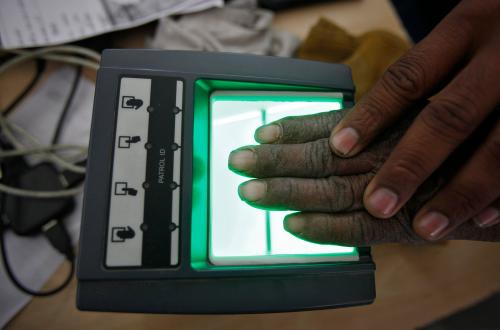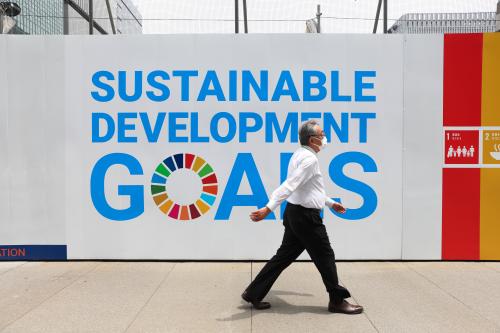The Paris Declaration of 2005 galvanized the aid effectiveness agenda around five core principles: country ownership, donor harmonization, alignment with country priorities, managing for results (for which evidence-based decisionmaking is essential), and mutual accountability (including transparency). The agenda has been widely adopted at the policy level, but less so in execution.
Aid effectiveness is not a static agenda. It was broadened at the 2011 Busan Fourth High Level Forum on Aid Effectiveness to extend to inclusive development. The 2014 U.S. Agency for International Development policy paper “Local Systems: A Framework for Supporting Sustained Development” emphasized the importance of taking a systems approach. Two additional concepts should be added—(a) “scaling,” or moving from small, short-term, siloed projects to sustainable activities reaching a significant portion of a population, and (b) “innovative technology,” as best represented by digital public infrastructure and goods, digital platforms and solutions that can serve many purposes and communities and on which multiple services can be built.
Scaling
While there is no firm agreement on the definition of scaling, experts Johannes Linn and Richard Kohl characterize scaling as “a systematic process leading to sustainable impact affecting a large and increasing proportion of the relevant need.”
Key elements of the emerging consensus on scaling are the same as those that have evolved in the application of the principles of aid effectiveness. A recent paper, “Crosscutting Issues Affecting Scaling,” enumerates the components of effective scaling, which track with lessons of aid effectiveness: adaptivity and flexibility; feedback and learning; a focus on results; partnerships and collaboration; participation and inclusion; and attention to power dynamics, gender equity, and other equities.
Also common to both, as laid out by Ann Mei Chang in her seminal work on how to innovate for greater social good, is the importance of envisioning the full scale of the task at the point of inception and executing through iteration. This basically involves reverse engineering – start with the vision, track back through the steps needed to achieve it, incorporate the ultimate goal into the original design, start with small experimentations, incorporate feedback, and adapt each successive iteration according to the feedback.
Further, successful scaling is context-specific and must account for constraints and opportunities in the ecosystem where it takes place. This links to system approaches to transformational change, as changes in the ecosystem (policies, politics, institutional capacities, and financing options) can help the scaling process for an individual innovation and for classes of innovations.
Another commonality of scaling and aid effectiveness learned from years of experience is the need for patience. Sustainable development takes a long time —10-15 years. Unfortunately, most donors—public and private—have a short time horizon, usually between three to five years and seven at best. Few entities have the sustained timeframe of a global network like Rotary, which for nearly 40 years has stuck to the task of eliminating polio—today 99 percent eradicated in all but three countries.
If development is to achieve the U.N. goals of Agenda 2030—represented foremost by goal #1, eliminating poverty—one-off projects will not suffice. If the world is to end hunger (633 million people undernourished as of 2017), secure good health (half the world lacks essential health services) and quality education (258 million children not in school as of 2019), reach gender equality (31.4 gender gap as of 2020), and the other goals, then development activities must be done at scale to reach the objective of traversing the last mile.
Digital public goods
Innovative technologies today are best represented in the digital transformation that is engulfing the world. In digitalization, it is public goods that make a particular contribution to inclusive sustainable development. Public goods are products or services that are “non-excludable and non-rivalrous” and readily accessible to anyone. As applied to information and communication technology, public goods are digital products or capabilities that are built on open-source software (i.e., ownership is in the public domain) and more specifically, involve “open source software, open data, open AI models, open standards, and open content.” Sometimes a distinction is made between digital public infrastructure (DPI)—the foundational digital platforms on which many digital applications can be built—and digital public goods (DPGs)—the specific applications. More generally, as in this post, DPG will be used for both concepts.
The fourth industrial revolution—the digitalization of economic, social, and political life—has been transformed by COVID-19 from a fast pace to warp speed that is touching nearly all peoples and communities, but not in equitable degrees. Individuals, communities, and countries with access to digital capabilities have sustained their welfare or even moved ahead. Students with access to computers and the internet have continued their studies, office workers with digital access have continued to get paid and protected their health by working from home, digital companies are thriving, and governments that have moved functions online can serve their public. But those without digital capabilities are being left behind.
A recent analysis of digital government capacity based on pre-COVID data evidences that all country income groups are increasing their digital capability. However, the data reveals that the digital divide with high-income countries is being gradually bridged by upper-middle-income countries, remains basically static for lower-middle-income countries, and is widening for low-income countries. The latter is true particularly for sub-Saharan Africa and also South Asia. These trends have likely continued with COVID-19, with wealthy countries progressing ahead.
While digital government capacity tracks closely with level of national income, it is political leadership and vision, not income, that is the determinant. This is evidenced by the actions of developing countries that met the coronavirus with digital government capability in place. Lower-middle-income India deployed its digital ID system Aadhaar to transfer $8 / month to 200 million vulnerable women. Sri Lanka used its digital health information platform to register and track incoming travelers. Even more telling, lower-income Togo adapted in 10 days its digital platform to provide monthly cash transfers via mobile phone, with 450,000 beneficiaries receiving funds within a week of the launch.
As in other areas, donor activity in the digital arena is concentrated on single-use solutions in specific sectors, with stories of inefficiency and incompatibility such as a field health worker having to collect and report data via multiple devices. But solutions at scale that serve multiple purposes and solutions and bring systems change—DPGs—are readily available. The Digital Impact Alliance maintains a catalogue of digital solutions able to be filtered by Sustainable Development Goals (SDGs) and other characteristics. The Digital Pubic Goods Alliance maintains a registry of 87 DPGs. The open-source platform MOSIP offers a digital ID for adoption by any country. While DPGs are not always the optimal solution and proprietary software has a role to play, DPGs offer software that is readily available, cost effective, and can serve as the basic building blocks for broad-based digital public platforms.
Aid effectiveness toolbox
Digital solutions can play a major role in advancing most of the SDGs and in making development solutions more effective and efficient. They offer development solutions at scale that can bring systems change. With an estimated 678 million people living in extreme poverty, scale and systems changes are essential if the SDGs are to be reached. DPGs and scale are key elements of the aid effectiveness toolbox.
But caution is in order. As valuable as DPGs are, digital capabilities also can bring “public bads” when deployed by authoritarian governments to restrict and control political dialogue—by social media to spread fake news and by hackers for ill-gotten gains. This is why donors are working hard to develop a charter to create guardrails that will focus the development of digital capabilities on public goods and constrain public bads.







Commentary
Aid effectiveness: Scaling and digital public goods
March 18, 2022